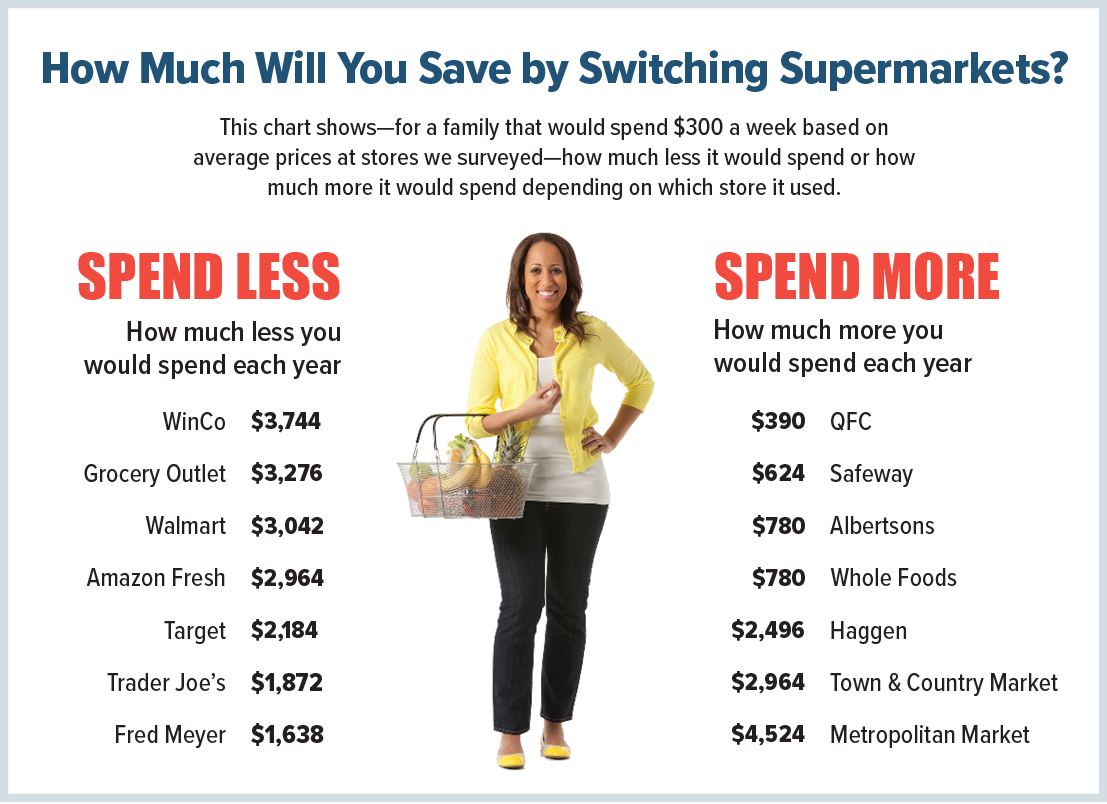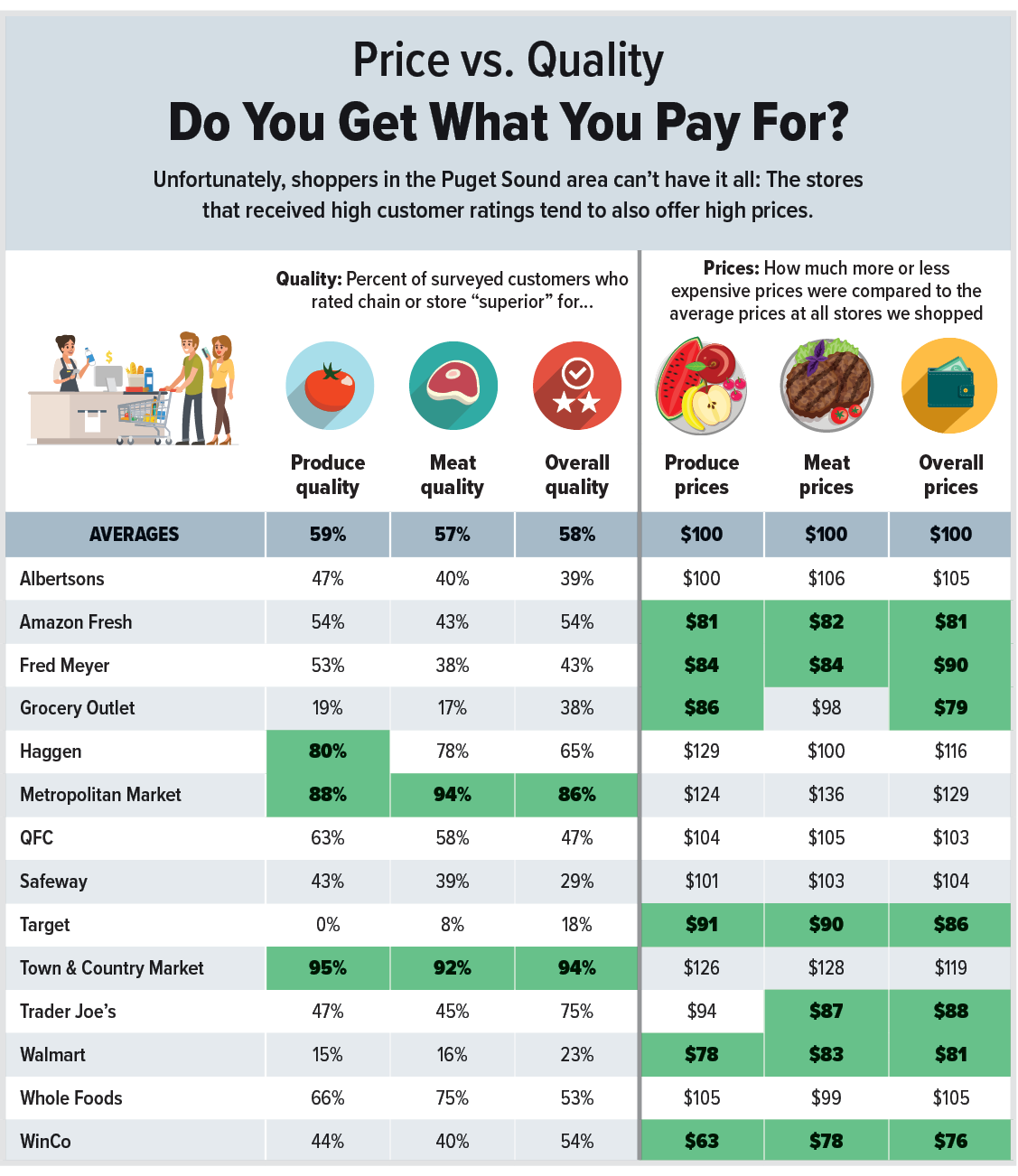Which Grocery Stores Offer the Best Prices and Quality?
Last updated November 2025

Our latest comparison of Puget Sound area supermarkets’ prices and quality is in the bag. Consumers’ Checkbook researchers shopped stores using a 150-item list to compare prices. To evaluate stores on quality of products and service, we surveyed our members. The figures below summarize our findings; for details, see our Ratings Tables. Here’s what we found:
Amazon Fresh, Grocery Outlet, Walmart, and WinCo offer the biggest savings.
WinCo offered prices about 24 percent lower than the average at all other stores we surveyed. Grocery Outlet, which offers a somewhat odd assortment of steeply discounted surplus national-brand products, offered prices that were about 21 percent lower than average. Amazon Fresh and Walmart each had prices about 19 percent lower than the all-store average.
For a family that spends $300 per week at the supermarket, a 24 percent price difference totals savings of $3,744 per year.
Amazon Fresh opened its first Puget Sound area location in 2021; the region now has a handful of stores and counting. These small-format stores focus on low costs and convenience (the company’s app keeps track of what you remove from shelves; when finished, you simply exit without scanning items).
Other price standouts: Fred Meyer and Target.
Target’s prices were about 14 percent lower than the average at all other stores we surveyed; Fred Meyer had prices about 10 percent lower.

Trader Joe’s remains popular and relatively inexpensive.
Seventy-five percent of survey respondents rated the funky-and-fun chain “superior” for “overall quality.” TJ’s prices were about 12 percent lower than the all-store average.
These savings are partly explained by Trader Joe’s smaller-format stores, which have much lower overhead costs than conventional supermarkets.
TJ’s also benefits from different expectations. Shoppers at Fred Meyer, Safeway, Walmart, etc., expect to always find their favorite brands on the shelves. But Trader Joe’s carries mostly its own brands, meaning you won’t find Coke, Heinz ketchup, Hellmann’s mayo, and other big names at TJ’s. So, its shoppers don’t expect wide choices of brands or sizes but trade that quirkiness for comparable very-low-priced products. (To account for brand differences, we used a modified market basket to compare Trader Joe’s prices with conventional supermarkets; click here for more info.)
Whole Foods remains expensive—and its ratings for quality continue to dip.
When Amazon purchased Whole Foods in 2017, many experts predicted the combination would punish its supermarket competition by combining Whole Foods’ solid reputation with Amazon’s pursuit of distribution perfection. Many consumers hoped they’d pay Amazon-like prices for Whole Foods-quality products. That hasn’t materialized.
Whole Foods built a loyal following by offering high-quality produce, meat, prepared foods, and generic staples. For years it earned high marks in our surveys of consumers, especially for produce and meat quality. Now, Whole Foods’ customers give it far lower scores: On our “overall quality” survey question its score has dropped to just 53 percent.
Our price survey found that Whole Foods remains an expensive choice among the large chains we shopped. Its overall prices were about five percent higher than the average prices at all stores we surveyed, or about 17 percent higher than Fred Meyer and 30 percent higher than Amazon Fresh, its corporate sibling.
Albertsons, QFC, and Safeway charge similar prices.
Overall, the stores we shopped for the area’s remaining traditional supermarket powers all had prices that were one to six percent higher than average. On average, they were 28 percent more expensive than Amazon Fresh and Walmart and 37 percent more expensive than WinCo.

On the quality side, the largest grocery chains performed dreadfully.
Albertsons, Fred Meyer, Grocery Outlet, QFC, Safeway, Target, and Walmart each failed to earn “superior” ratings overall from even half of their surveyed customers. Target scored lowest—only 18 percent of its customers judged it “superior” overall, and none thought highly of its fresh produce offerings.
The highest rated outlets are all small operators.
Central Co-op, Metropolitan Market, PCC Community Markets, Thriftway, and Town & Country were all rated “superior” for produce quality and for overall quality by more than 85 percent of their surveyed customers.
Unfortunately, the stores that rate highest for quality charge high prices.
Metropolitan’s prices were about 29 percent higher than the all-store average; the Town & Country location we shopped had prices 19 percent higher than average.
Within the largest chains, there is relatively little store-to-store price variation.
Prices at the Albertsons, Fred Meyer, QFC, Safeway, and Walmart locations we surveyed were about the same from store to store.
We also checked out Costco, looked at Trader Joe’s, and examine grocery delivery options.
Check out the other articles in our “Grocery Stores” category and our ratings tables for info on all the local grocery options, how we rated them, and tips on saving no matter where you shop.

